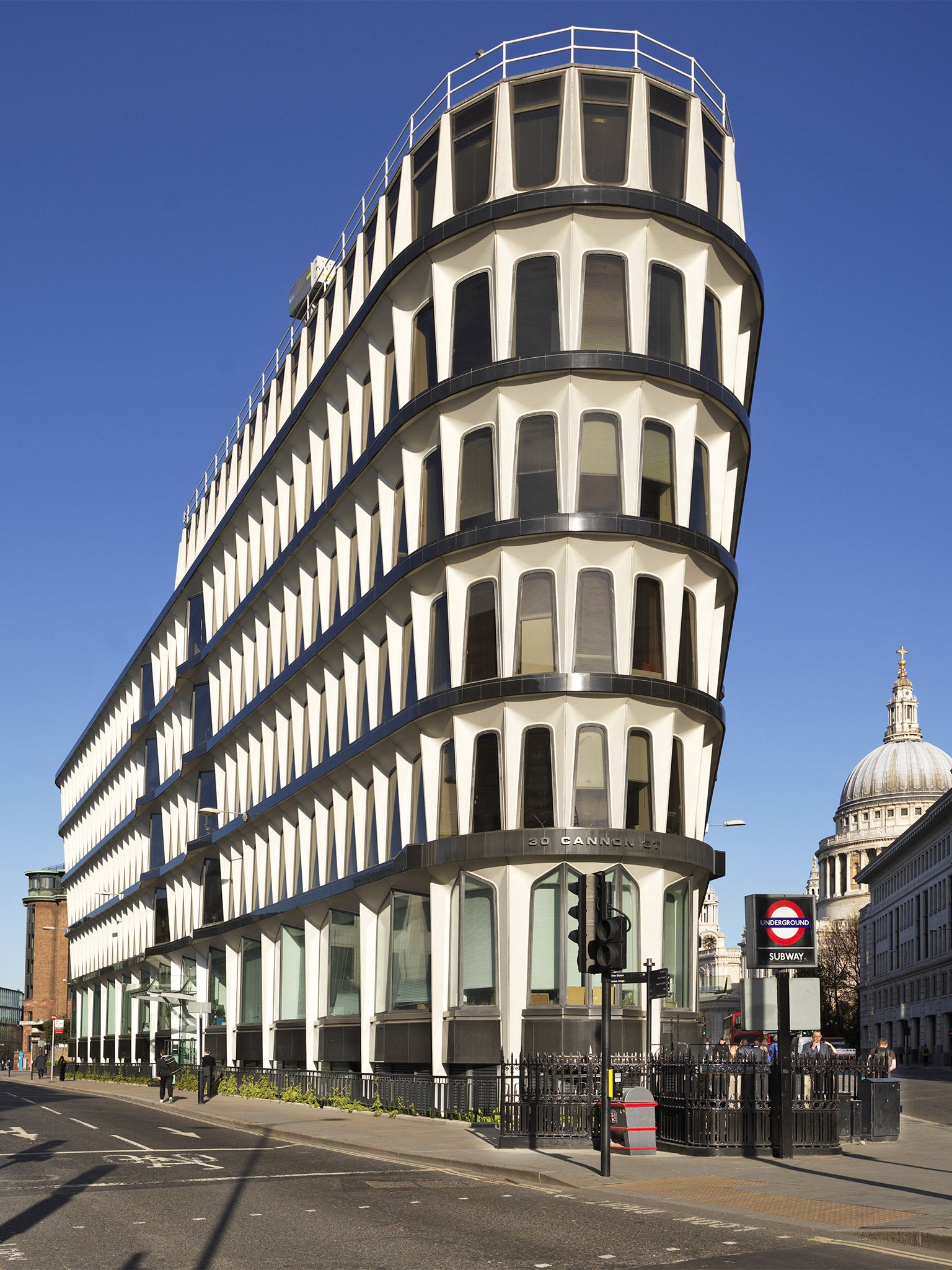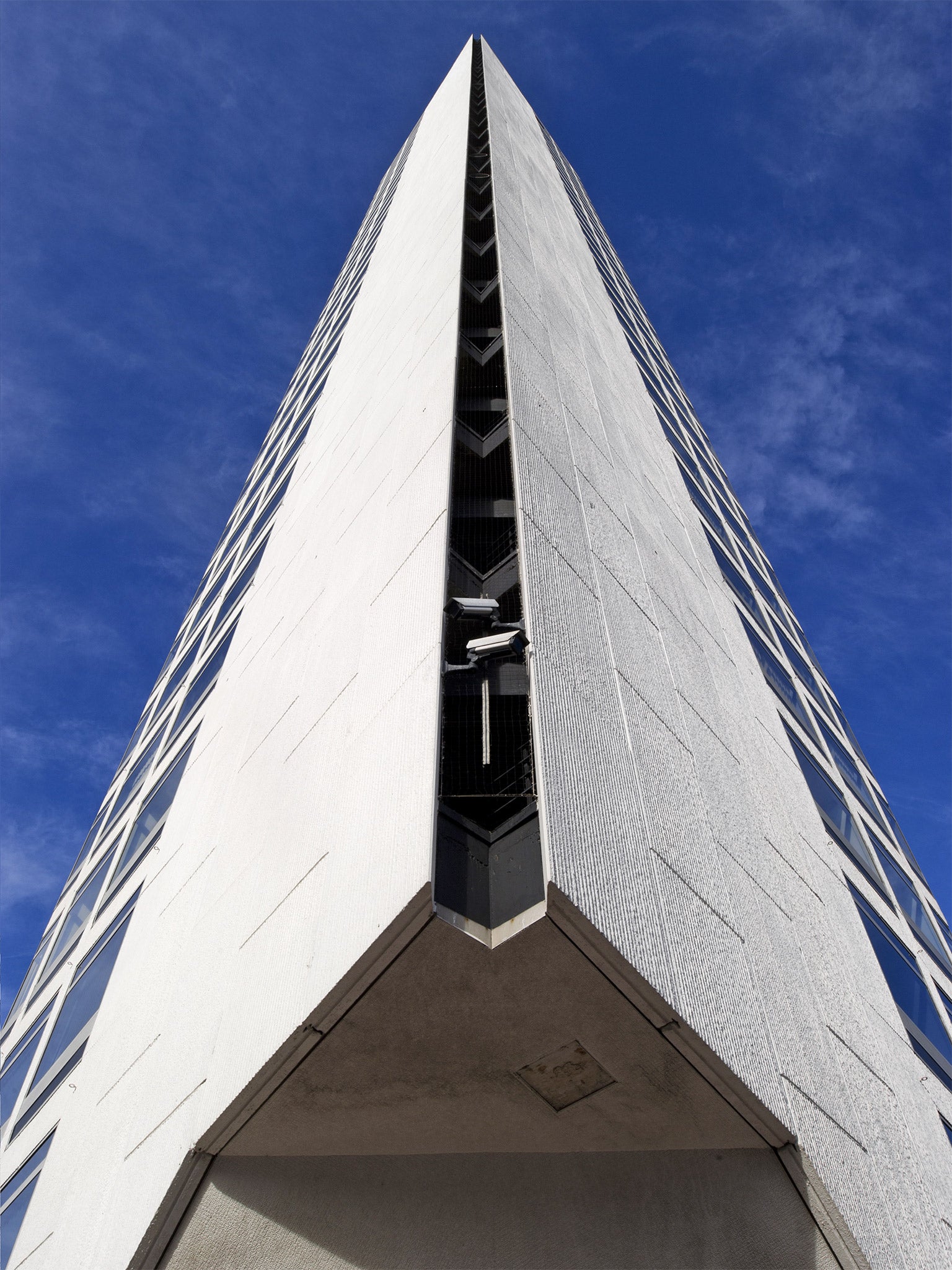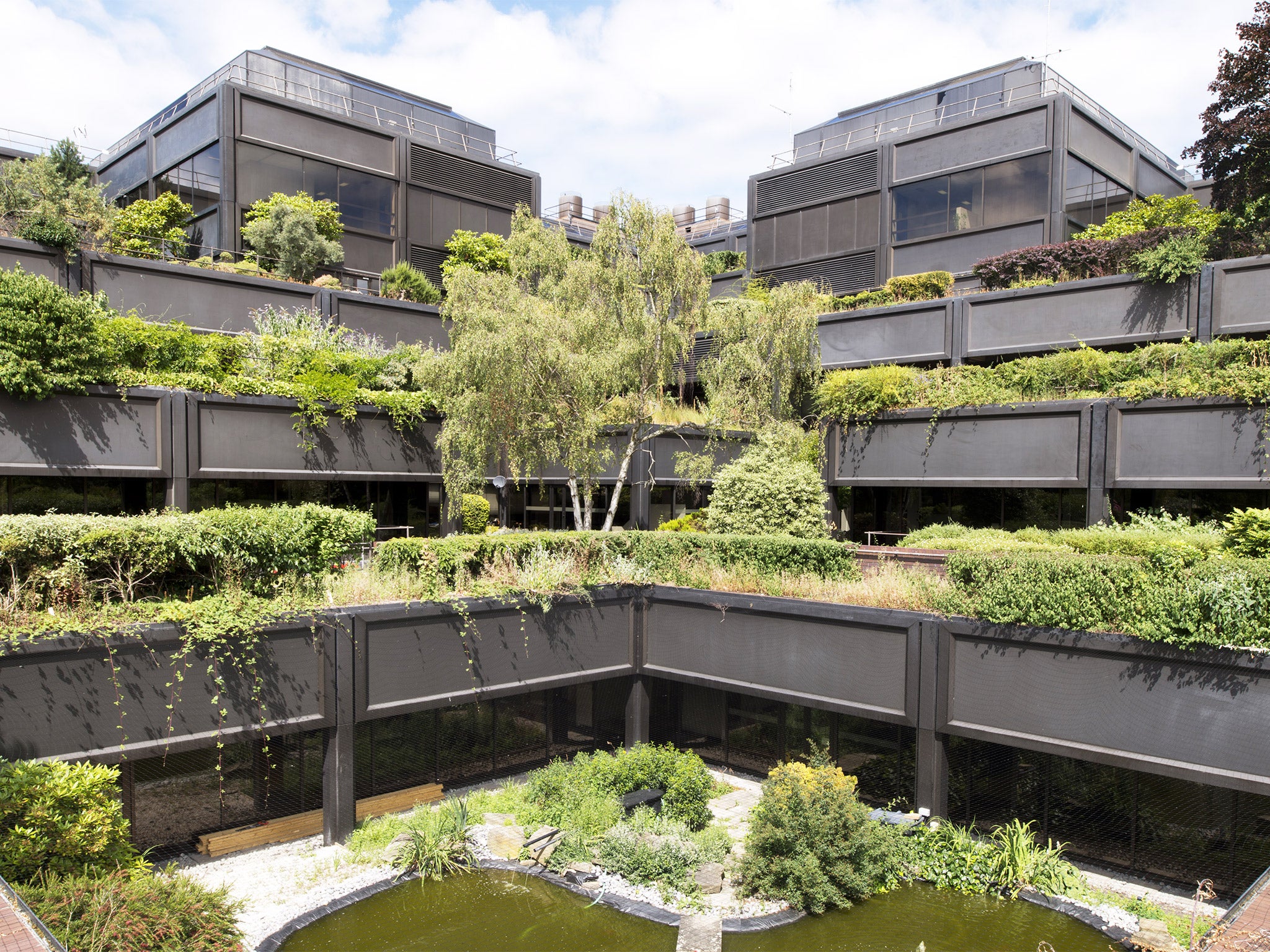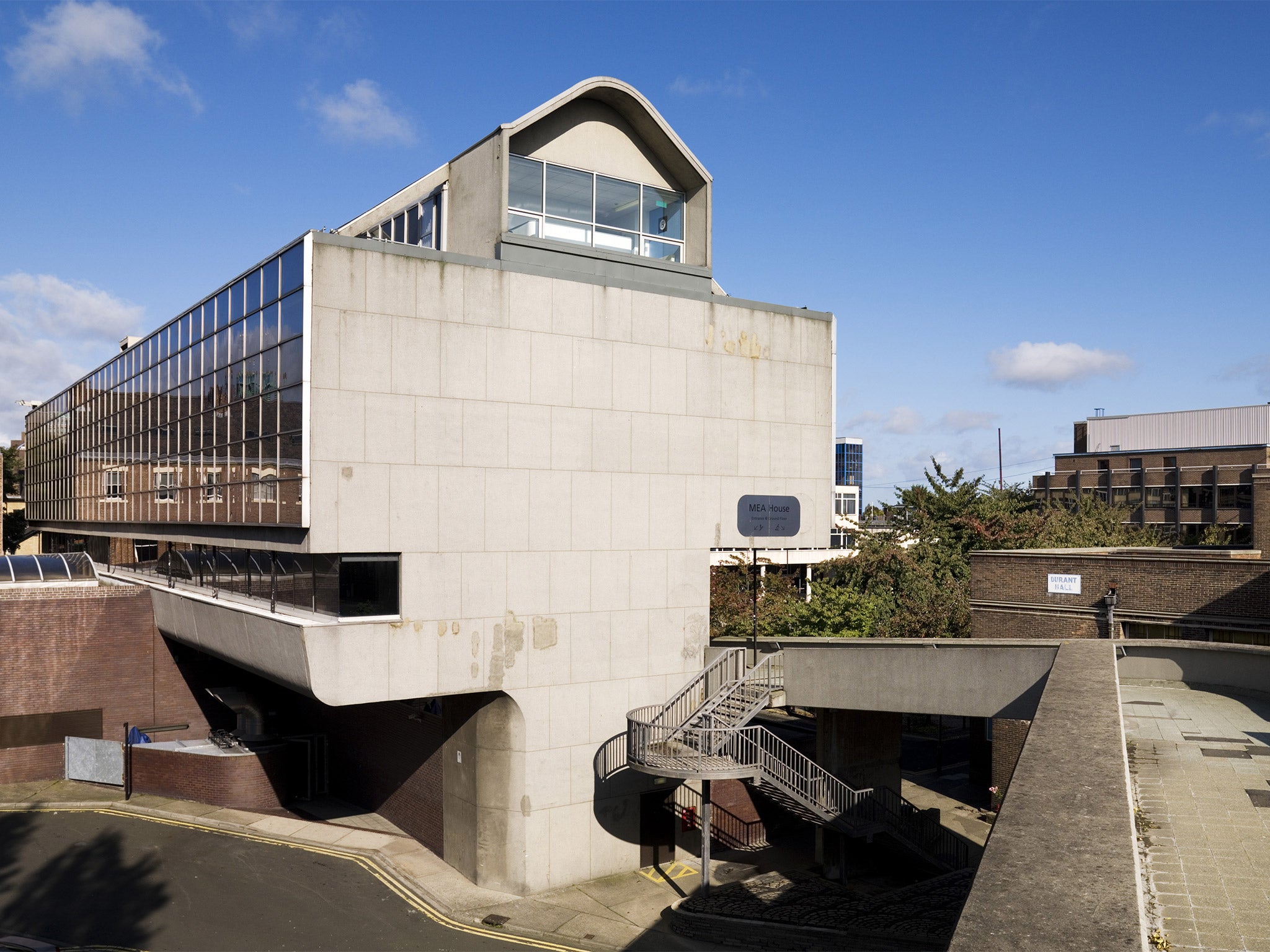English Heritage adds 14 post-war office buildings to its protected lists
Christopher Beanland explores the underrated appeal of these palaces of pen-pushing

"It's one of the more daring buildings in the City, one of the more assertive," says Roger Bowdler. With his jacket and Likely Lads grin, he looks like an architect from the 1970s. Which is appropriate, because we're standing, looking up at 30 Cannon Street. Built as an outpost of French bank Credit Lyonnais in 1977, it was the first building in Britain to use glass-reinforced cement.
For this reason, and because its keyhole windows and leaning gait display a two-fingers-up Gallic swagger, even though the architects Whinney, Son & Austen Hall are British, it has this week been listed.
It's Monday afternoon in the City of London. Bowdler, English Heritage's director of designation, and three of his affable colleagues, are walking me round some of the 14 offices to which the public body has just given Grade II listing – 28 offices had previously been listed.
Culture secretary Ed Vaizey has approved them all. I ask the English Heritage assessor Geraint Franklin whether he thinks that offices are an architectural Cinderella, destined to be ignored and neglected.
"Definitely," he says. "It's curious that the history of this working environment – the office building – is still being written. It's a fascinating story about a young but constantly evolving building type."
What do offices mean to us? They're anonymous, private, policed spaces. We ignore the ones we walk past, because they put up plate glass and security barriers, and we endure those that we work inside. Walk the Square Mile, Canary Wharf, or the financial districts of Leeds and Birmingham on a Sunday, and it's like the opening credits of the film 28 Days Later. Deserted, eerie and out of human scale.
Offices don't do public space well as a rule, and people don't linger.
But the time, it seems, has come to see something more in them. Bowdler explains that while English Heritage recognised other types of building, post-War offices had slipped under the radar – hence the glut of listings now. "All of the time you're thinking of the longer term, handing on the best to the next generation," he said.
Of course, listing a building doesn't necessarily afford it protection from demolition or even from being heavily altered. Listing does not freeze a building in time, it simply means that listed building consent must be applied for to make any changes to that building that might affect its special interest. But listing celebrates exceptional architectural or historical importance, and is the first line of defence when it comes to rapacious redevelopment.
Wandering the streets with my gang of English Heritage experts is like playing truant, staring through office windows while inside, people slave away. We pass 1 Finsbury Avenue, a sleek box by Peter Foggo from the 1980s; then Brown Shipley, a dour bank by Fitzroy Robinson. The new listings outside London are more exciting: Ryder & Yates's MEA House in Newcastle, BDP's posh-brutalist 1971 Bank of England in Leeds, and John Madin's refined Engineering Employers Federation in Birmingham. Madin's forthright NatWest Tower, a brilliant sore thumb on the Birmingham skyline, was assessed for listing, but turned down.
"The result may confirm my theory that it's not the best buildings that get listed, just the least troublesome," says Alan Clawley, author of a book on Madin. "But I'm pleased about the Engineers building, as it began Madin's career."

Several years ago, Jonathan Meades was also sceptical when he wrote an essay criticising English Heritage's failure to protect brutalism from the wrecking ball. We don't celebrate offices in the way that we laud housing, schools, galleries, churches. One of the few places they get attention is in television and film comedy. And then it's not only their architecture that gets ridiculed, but their atmosphere. The Office, The IT Crowd, Office Space and Peep Show make excellent use of the inertia, institutional pettiness and stationery-cupboard snogging that are the shorthand for office life.
The fictional JLB Credit is the archetypal office where much is said yet nothing matters – a fact that Peep Show's Jeremy can see, but Mark can't always accept. On some level, we sense which time spent in the office is wasted time, that we could be using making music, painting, running our own business, anything. We want to be Jeremy, but we're stuck being Mark.
Yet offices anchor us. "We spend shocking amounts of our time in offices, it would be strange if we weren't somehow affected by them," says Nikil Saval, author of the recent book Cubed: A Secret History of The Workplace. Under the glow of fluorescent lights, 10 million of us clockwatch in places that, while being different in some ways, are linked by a common thread: desks, computers, tea, mediocre art in the foyer. "We spend something like one third of our adult lives at work," says Franklin, the assessor. You're probably reading this on the way to an office, or on a bright screen in one. We sit in them five days a week, we find love (or lust) there. When meaningful things happen to us at work, as in any building, architecture goes from being bricks and mortar to the film set for our own lives.

Saval believes that "many office buildings are stunning. The facing towers of Mies Van Der Rohe's sombre Seagram Building and Skidmore, Owings & Merrill's gleaming Lever House are two of the best." This pair of debonair souls sit opposite each other on Manhattan's Park Avenue, four blocks from the Time-Life Building where Mad Men – another TV office classic – was set. He also rates "the office of the Madrid architecture firm Selgas Cano, housed in bent, transparent plexiglass."
Selgas Cano has just come to Britain with Second Home, which opened last month. It's an old carpet factory off east London's Brick Lane that they converted to offices. Behind its citrus plexiglass exterior is a veritable hive of technology companies housed in oddly shaped nooks.
It's become a cliché that technology and media companies compete to have increasingly wacky workplaces: table tennis equipment, sandpits, communal desks and rooftop bars.
These design features say 2000s in the same way that the recalcitrant photocopier, shoddy dividers and grubby mugs did the 1980s. Second Home looks full of interesting people lounging on mismatched furniture, laughing. Perhaps because only companies or workers who have been "invited" to rent office space here are allowed in. Today's elitism is about who gets invited to the party, not who gets the corner office and the secretary.

How else has the office changed? "Technology has had a tremendous effect on the space of the office," says Alexandra Lange, writer for The New Yorker and The New York Times. We are now at an all-time low in square footage allotted per worker, and that's because of the disappearance of paper and files into computers, and the appearance of headphones.
"In fact, I think of headphones as an invisible cubicle because they are the only things that make work possible in such close quarters." Today, though, we're finally looking back and realising that, actually, our anonymous post-War office blocks sometimes possessed verve. Hoteliers have certainly taken a keen interest. Birmingham's (listed) Rotunda has a hotel, and Sea Containers House in London and Marcel Breuer's Ameritrust Tower in Cleveland were both converted into hotels last year.
The annex to the Town Hall in Camden – where architects such as Neave Brown designed lavish, innovative council estates – will become a Standard Hotel. If old offices make perfect hotel rooms, old factories are increasingly today's open-plan offices; spaces that dance on the dead body of Britain's manufacturing past.

Whatever the future holds, English Heritage has highlighted the recent past of offices. And nobody epitomises British office design like Richard Seifert. Nicknamed "The Colonel" – his rank when in the Royal Engineers – he constructed a fortune for himself, creating buildings across nearly every British city. Building magazine estimated that he put up at least 600. Many were made with reclusive developer Harry Hyams, who legendarily left Centre Point empty for nine years.
Seifert and partner George Marsh influenced the design of offices many of us work in to this day. Their blocks, the chunky and unrepentent Space House in Holborn, and Alpha Tower – the former offices of ATV in Birmingham, which shares a sleekness and a sharpness with Concorde's design – have also both just received the listing nod.
Office buildings such as these can be fascinating, even if office life inside them drives us to distraction. As Mark's friend Daryl says in Peep Show: "I don't know about you – but I'm so bored I could eat a stapler." Perhaps he should have spent more time looking out of JLB's windows at Croydon's weirdly compelling forest of office blocks.
Join our commenting forum
Join thought-provoking conversations, follow other Independent readers and see their replies
Comments
Bookmark popover
Removed from bookmarks